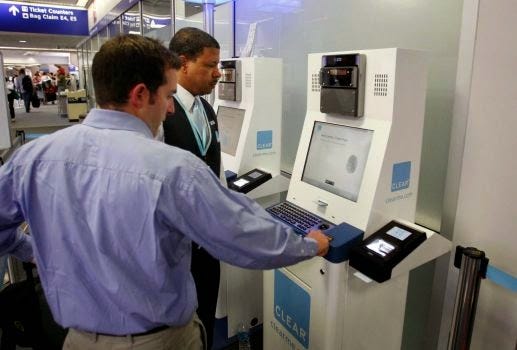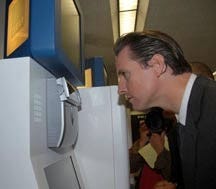DHS & airports use your fingerprints, iris & facial biometrics to spy on you

Travelers willing to pay an annual fee could have an easier time making their way through security checkpoints beginning later this summer at McCarran International Airport.
Clear, a New York-based technology business, announced today that McCarran would be the 10th airport in the country where prescreened members can use their Clear Card to speed through security checkpoints.
The company uses government-approved, advanced-biometric technology (fingerprints and iris recognition) to verify the identity of Clear Card users.
“We are thrilled to be bringing Clear to Las Vegas,” said Caryn Seidman Becker, chief executive officer of Clear.”
Clear said it anticipated launching dedicated members-only security lanes and enrollment kiosks in mid-August in three of McCarran’s checkpoints. Typically, the company said, members get through airport checkpoints in less than 5 minutes. Clear members still must go through security screening.
Annual membership fee is $179. Members can add a spouse or partner for $50 annually; there is no cost for members’ children under 18.
“The department (DHS) is exploring additional biometric modalities such as face and iris to determine what may be possible to implement in our operational environments, whether it be for enforcement or Trusted Traveler programs,” Kimberly Weissman, spokeswoman for the office of US-VISIT, which is responsible for Homeland Security’s ID database.
In the "near future," she added, US-VISIT and Customs and Border Protection officials will try out technologies that match irises, and potentially faces, of people officials suspect have entered the country illegally in Texas. The program is a follow-up to an earlier iris trial.
“The pilot is planned for the Border Patrol station in McAllen, Texas, and will test the feasibility and accuracy of iris capture and matching in an operational environment,” CBP spokeswoman Stephanie Malin said. “This also includes storing a facial recognition-quality photograph.”
DHS envisions many other convenient applications of biometrics for U.S. citizens and foreign nationals, said Williams, now an executive at Daon, an ID verification software provider hired to help simplify US-VISIT’s architecture. For instance, at a pedestrian crossing such as the border checkpoint in San Ysidro, Calif., “before you even get to an officer, you could do an iris scan so that by the time you walk up to the officer’s desk, they know who you are and anything derogatory about you," he said.
Homeland Security's experimentation with analyzing physical characteristics other than fingerprints to confirm identity and to detect fraud coincides with other recent ventures into multimedia biometrics governmentwide. This week, the Obama administration announced preliminary procedures for embedding iris images into federal employee identification cards and the FBI is propping up a repository of iris files to augment its fingerprinting database, partly by collecting images from municipal jails that use iris recognition for tracking prisoners. The bureau’s criminal ID database, which added a small facial recognition program in early 2012, is undergoing a multiyear $1 billion upgrade to accommodate many physical characteristics, such as vocal recordings or photographs of tattoos.
During the Texas border project, Homeland Security will collect snapshots of irises and faces, as well as biographical information from immigrants arrested in the Southwest, Malin said. The practice run follows a similar iris-matching program in 2010 when, according to former US-VISIT officials, Border Patrol officers photographed suspects’ irises during booking and again upon release to see if the database could accurately match live images with previously recorded images. The test demonstrated that enrolling the accused’s irises largely did not disrupt normal operations, Malin said.
Our politicians have been pushing for a national biometric ID card.
No amount of bipartisan support can make biometric ID cards a good idea. The logistics would be a burden upon millions of Americans. The costs of creating such a system would be enormous, and the threat of a security breach constant. Not only will biometric ID cards be a tough sell to the public.
A national biometric ID would be hugely expensive. A 2012 study by the University of California at Berkeley estimated that creating such a system would cost $40 billion initially, with annual maintenance costs of $3 billion. These figures include the expenses of training workers to examine documents, issue cards, and verify employment eligibility, as well as the expenses of new hardware and software. Add into this the costs to employers, who would be required to have card scanners, which could prove problematic for medium-sized and small businesses.
A national database would mean that any security breach – one successful hacking into the encrypted data – would put the personal information of millions at risk of identity theft. This is a very real possibility. Between 2000 and 2008, federal and state governments mishandled or exposed 530 million records with personal data. And these are only the security breaches that have been publicly reported.
True, many Americans provide biometric data for credit cards, and our cell phones contain a trove of personal information. However, these are voluntary activities.
Banks in other countries require customers to give them biometric info. Click here to read more.
Americans would have no way to ensure that their data is used only for its intended purpose, and not for surveillance or unauthorized monitoring. No wonder Chris Calabrese of the American Civil Liberties Union calls biometric ID cards “a massive invasion of people’s privacy.”
"The concern is that biometrics will be used for the mass tracking of individuals," according to Jay Stanley of the American Civil Liberties Union. "If that kind of ID system becomes routine and widespread, it turns us into a kind of checkpoint society." Even in India, the system is still only used at police stations and government offices, but once the print is connected to a universal ID, it's easy to imagine iris scans becoming as commonplace as pulling out a driver's license.
Iris scanning is not infallible, click here, here and here to find out more.
Clear currently operates in nine airports across the country: San Francisco, San Jose, Denver, Dallas-Fort Worth, Houston Bush, Houston Hobby, San Antonio, Orlando, and Westchester County, N.Y.
The company says it has a base of more than 300,000 members nationwide who have used its system almost two million times for travel.
These airports operated the Clear Registered Traveler program until and other Registered Traveler programs:
Albany International Airport
Cincinnati Northern Kentucky International Airport
Denver International Airport
Gulfport-Biloxi International Airport
Hartsfield-Jackson Atlanta International Airport
Indianapolis International Airport
Jacksonville International Airport
LaGuardia International Airport
Little Rock National Airport
Logan International Airport
John F. Kennedy Airport
Newark Liberty International Airport
Norman Y. Mineta San Jose International Airport
Oakland International Airport
Orlando International Airport
Reno/Tahoe International Airport
Ronald Reagan Washington National Airport
San Francisco International Airport
Salt Lake City International Airport
Washington Dulles International Airport
Westchester County Airport
These airports are currently implementing RT programs:
Toronto Pearson International Airport
The following airports have expressed interest and/or have requested TSA approval for the RT program:
Baltimore-Washington International Thurgood Marshall Airport
Birmingham International Airport
Chicago Midway International Airport
Huntsville International Airport
Los Angeles International Airport
O'Hare International Airport
Pittsburgh International Airport
Springfield-Branson National Airport
Ted Stevens Anchorage International Airport
http://www.lasvegassun.com/news/2014/jun/18/bio/
http://nbclatino.com/2013/02/04/opinion-no-amount-of-bipartisan-support-can-make-biometric-id-cards-a-good-idea/
http://www.nextgov.com/big-data/2012/07/feds-significantly-expand-use-iris-recognition-technology/56776/



